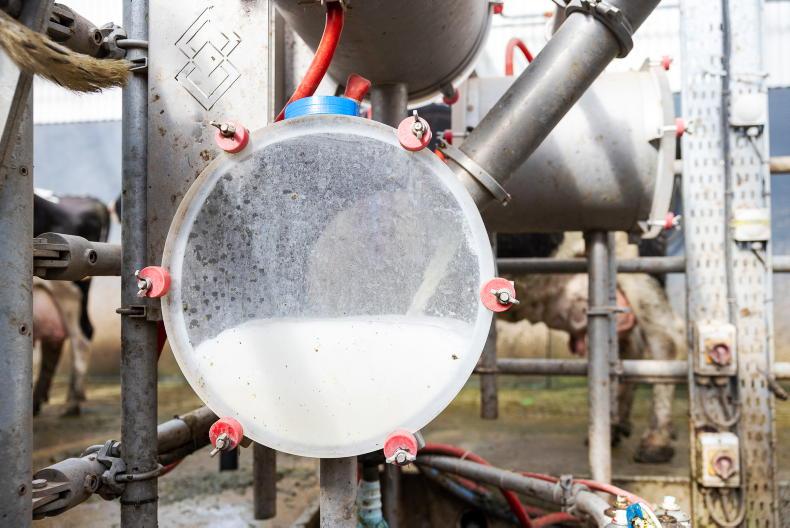The recent establishment and remit given to the Food Vision Dairy Group by Minister for Agriculture Charlie McConalogue was a watershed moment for the dairy sector.
It essentially signalled the end of unbridled expansion for the country’s milk suppliers.
Indeed, while 2015 will be remembered as the year when the milk-quota shackles finally came off, 2022 looks like it will go down as the year when the spancel went back on.
Minister McConalogue has tasked the new stakeholder group, which includes the farm organisations and dairy processors and is chaired by former Teagasc director Professor Gerry Boyle, with devising an industry strategy that will “stabilise” and “reduce” carbon emissions from the dairy sector.
Big ask
This is a big ask, particularly since the Minister wants draft proposals by the end of March and a detailed plan before July.
The challenges faced by the new group are further complicated by the fact that:
The Irish Creamery Milk Suppliers Association (ICMSA) and the Irish Farmers' Association (IFA) are adamant that they will not be party to the formulation of policies that effectively stymie their members’ incomes.The dairy processors have serious misgivings around the reintroduction of a new type of milk quota.Any new strategy will have to include a mechanism to handle additional dairy replacements - more than 200,000 dairy calves and heifers that are already in the pipeline and due to come into the dairy herd over the next two to three years. And the next breeding season is only around the corner. So what are the options open to Prof Boyle and the dairy sector stakeholders when they meet on Monday 7 February?
The general consensus among industry observers is that a simple straightline compensation for a cull in cow numbers, like the most recent policy announced in the Netherlands, is very unlikely. The Minister is afraid to do that for suckler cows, so he’ll hardly do it for the dairy herd.
There is an acceptance that it is the simplest and probably most effective short-term solution to the problem, but it is considered a politically toxic approach.
Rural electorate
“Unlike the current Dutch government, Fine Gael and Fianna Fáil are too plugged into the rural electorate to countenance such a draconian approach,” one source maintained.
Similarly, it is thought unlikely that the former milk quota regime will make a return at national level.
While such an approach would be workable from the Department of Agriculture perspective, the dairy processors are understood to have serious reservations around operating quotas.
Milk quotas
“Co-ops are not statutory bodies,” one co-op official said. “We don’t want to have to manage a new quota regime,” he added.
Could the peak milk controls imposed by Glanbia as a result of the planning delays in Belview provide a template to curtail dairy growth nationally?
Some in the industry believe they could, but really this might only shift milk from one part of the year to another, since Glanbia wants more milk, just not in March, April, May and June.
“There is no doubt that the Department [of Agriculture] learned a lot from Glanbia’s experience,” one industry source maintained.
Others in the sector agree that a variant of the Glanbia model has merit. They maintain that a ‘Glanbia-like’ model could offer a possible compromise solution, with farmers’ supply contracts with their processors effectively becoming the new quota.
Under such a scenario, growth in the milk pool and at farm level would be allowed. However, it could be restricted to less than 1% or 2% rather than 5.5% recorded last year.
Retirement package
A key proposal in a ‘Glanbia-like’ plan would be a buy-out or retirement package for those who wish to exit dairying. A proportion of this milk would then be allocated to new entrants.
All farmers would require sufficient slurry storage, spread slurry using low emissions-spreading slurry (LESS) equipment, use protected urea while reducing overall fertiliser usage and adopt other environmental measures.
The hope is that such an approach would reduce NO2 and CO2 output from dairying over the next four to five years, while also stabilising cow numbers and methane emissions.
Could the draft nitrates action plan (NAP) be employed to further curb cow numbers or will we see estimated carbon quotas per farm being introduced?
Consensus
The NAP could play a role; it already limits organic nitrogen (slurry) and artificial nitrogen (bag fertiliser).
However, the consensus is that it is more likely to inform the regulatory framework within which farmers will operate, rather than being a tool by which to devise policy. Effectively, it will be the stick.
Putting in place estimated carbon or greenhouse gas quotas per farm certainly has merit.
While the technology and data is not there yet to establish exact carbon quotas per farm, estimated emissions research values can be calculated quite easily.
Moreover, this approach has the added attraction of being applicable in the beef and sheep sectors. There is little point in limiting dairy cows to see suckler cows increasing and overall emissions from the national herd continuing to grow.
Carbon quotas
It might also be a case that the industry migrates to carbon quotas as the science improves in the coming years.
The discussions of the Food Vision Dairy Group over the next six weeks are likely to define how the dairy industry develops over the next decade.
It will be a real test of Prof Boyle and the various stakeholders to divine a strategy for the dairy industry that they can all sign up to and sell to their members, while crucially meeting the carbon reduction targets demanded by Government.
This is truly a watershed moment for the sector.
The recent establishment and remit given to the Food Vision Dairy Group by Minister for Agriculture Charlie McConalogue was a watershed moment for the dairy sector.
It essentially signalled the end of unbridled expansion for the country’s milk suppliers.
Indeed, while 2015 will be remembered as the year when the milk-quota shackles finally came off, 2022 looks like it will go down as the year when the spancel went back on.
Minister McConalogue has tasked the new stakeholder group, which includes the farm organisations and dairy processors and is chaired by former Teagasc director Professor Gerry Boyle, with devising an industry strategy that will “stabilise” and “reduce” carbon emissions from the dairy sector.
Big ask
This is a big ask, particularly since the Minister wants draft proposals by the end of March and a detailed plan before July.
The challenges faced by the new group are further complicated by the fact that:
The Irish Creamery Milk Suppliers Association (ICMSA) and the Irish Farmers' Association (IFA) are adamant that they will not be party to the formulation of policies that effectively stymie their members’ incomes.The dairy processors have serious misgivings around the reintroduction of a new type of milk quota.Any new strategy will have to include a mechanism to handle additional dairy replacements - more than 200,000 dairy calves and heifers that are already in the pipeline and due to come into the dairy herd over the next two to three years. And the next breeding season is only around the corner. So what are the options open to Prof Boyle and the dairy sector stakeholders when they meet on Monday 7 February?
The general consensus among industry observers is that a simple straightline compensation for a cull in cow numbers, like the most recent policy announced in the Netherlands, is very unlikely. The Minister is afraid to do that for suckler cows, so he’ll hardly do it for the dairy herd.
There is an acceptance that it is the simplest and probably most effective short-term solution to the problem, but it is considered a politically toxic approach.
Rural electorate
“Unlike the current Dutch government, Fine Gael and Fianna Fáil are too plugged into the rural electorate to countenance such a draconian approach,” one source maintained.
Similarly, it is thought unlikely that the former milk quota regime will make a return at national level.
While such an approach would be workable from the Department of Agriculture perspective, the dairy processors are understood to have serious reservations around operating quotas.
Milk quotas
“Co-ops are not statutory bodies,” one co-op official said. “We don’t want to have to manage a new quota regime,” he added.
Could the peak milk controls imposed by Glanbia as a result of the planning delays in Belview provide a template to curtail dairy growth nationally?
Some in the industry believe they could, but really this might only shift milk from one part of the year to another, since Glanbia wants more milk, just not in March, April, May and June.
“There is no doubt that the Department [of Agriculture] learned a lot from Glanbia’s experience,” one industry source maintained.
Others in the sector agree that a variant of the Glanbia model has merit. They maintain that a ‘Glanbia-like’ model could offer a possible compromise solution, with farmers’ supply contracts with their processors effectively becoming the new quota.
Under such a scenario, growth in the milk pool and at farm level would be allowed. However, it could be restricted to less than 1% or 2% rather than 5.5% recorded last year.
Retirement package
A key proposal in a ‘Glanbia-like’ plan would be a buy-out or retirement package for those who wish to exit dairying. A proportion of this milk would then be allocated to new entrants.
All farmers would require sufficient slurry storage, spread slurry using low emissions-spreading slurry (LESS) equipment, use protected urea while reducing overall fertiliser usage and adopt other environmental measures.
The hope is that such an approach would reduce NO2 and CO2 output from dairying over the next four to five years, while also stabilising cow numbers and methane emissions.
Could the draft nitrates action plan (NAP) be employed to further curb cow numbers or will we see estimated carbon quotas per farm being introduced?
Consensus
The NAP could play a role; it already limits organic nitrogen (slurry) and artificial nitrogen (bag fertiliser).
However, the consensus is that it is more likely to inform the regulatory framework within which farmers will operate, rather than being a tool by which to devise policy. Effectively, it will be the stick.
Putting in place estimated carbon or greenhouse gas quotas per farm certainly has merit.
While the technology and data is not there yet to establish exact carbon quotas per farm, estimated emissions research values can be calculated quite easily.
Moreover, this approach has the added attraction of being applicable in the beef and sheep sectors. There is little point in limiting dairy cows to see suckler cows increasing and overall emissions from the national herd continuing to grow.
Carbon quotas
It might also be a case that the industry migrates to carbon quotas as the science improves in the coming years.
The discussions of the Food Vision Dairy Group over the next six weeks are likely to define how the dairy industry develops over the next decade.
It will be a real test of Prof Boyle and the various stakeholders to divine a strategy for the dairy industry that they can all sign up to and sell to their members, while crucially meeting the carbon reduction targets demanded by Government.
This is truly a watershed moment for the sector.









SHARING OPTIONS